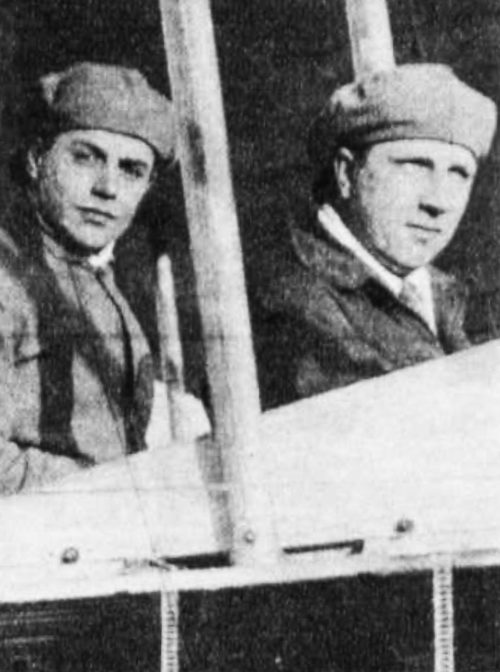Courage in the clouds
All Our Yesterdays looks back 25 years to a flight from Liverpool to New York


IN mid-Atlantic a storm rages. Two men in an open biplane fight for their lives. They are caught in the flier’s nightmare — cumulo-nimbus cloud. Gales threaten to tear their plane apart. Their air-speed indicator has failed. Their radio transmitter has failed. The heating in their suits has failed.
Down, down, down — the cloud-blinded pilot can do nothing. Suddenly the clouds break—only feet above the raging sea. The plane skims the waves. Spray splashes the fliers.
Their lives — and history — hang in the balance. Then, miraculously. the plane pulls out and zooms back into the sky …
All this happened to John Alcock and Arthur Whitten-Brown in June, 1919, when they were the first men to fly the Atlantic non-stop. Today more than 500,000 people fly by commercial air line between Britain and America each year.
They travel in foam-rubber, air-conditioned, pressurised luxury. Pretty girls wait on them. They can drink champagne and enjoy a six-course meal.

The hazards of an early Atlantic flight are vividly recalled in Granada’s All Our Yesterdays on Monday, when the newsreels of a quarter of a century ago remember the unsuccessful Transatlantic flight of Merrill and Richman.
On September 14, 1936, the fliers set off from Liverpool in a Vultee II called Lady Peace. Destination: New York. They never made it.
Their plane ran into trouble over Newfoundland, and they had to put down in Musgrave Harbour.
All Our Yesterdays traces the Transatlantic story — from the pioneering of Alcock and Brown to the last days of the great airships.
The flight of Alcock and Brown, both Manchester men, has been claimed to be the greatest flying feat of all time. This is understandable.

Time and again they escaped death by inches.
Time and again only sheer courage carried them through.
After escaping from the cumulo-nimbus cloud, their plane flew into rain, ice and snow — and the port engine iced up.
Brown crawled across the wing and used a knife in his bare hand — in the freezing propeller slipstream — to chip ice away.
Brown climbed out on to the wing six more times before landing.
And even the final touchdown was dramatic.
The fliers thought an Irish bog was a landing field — and put their plane down in the middle of it!

First solo flight of the Atlantic was by Charles Lindbergh in his single engined monoplane, The Spirit of St. Louis in 1927.
After a completely uneventful journey, Lindbergh nearly lost his life — being mobbed by admirers.
When his plane landed at Le Bourget 120,000 people were waiting. They trampled down fences, broke police cordons, and hauled Lindbergh from the plane in hysterical adulation.
He was in danger of being putted to pieces until the French pilot, Raymond Orteig, came to his rescue. He put Lindbergh’s flying helmet on the head of a journalist.
Before the astonished journalist realised what was happening he had been swept upon the shoulders of the crowd and acclaimed as Lindbergh, while the flyer was smuggled away.
But if Lindbergh was the darling of the crowds, James Mollison, the first man to fly both the North and the South Atlantic solo, was the darling of the Press.
Mollison was in evening dress in a New York night club when he was told that weather conditions over Atlantic were favourable.
Mollison went to the field, climbed into his Havilland Puss Moth, and flew the Atlantic — without even bothering to change.



